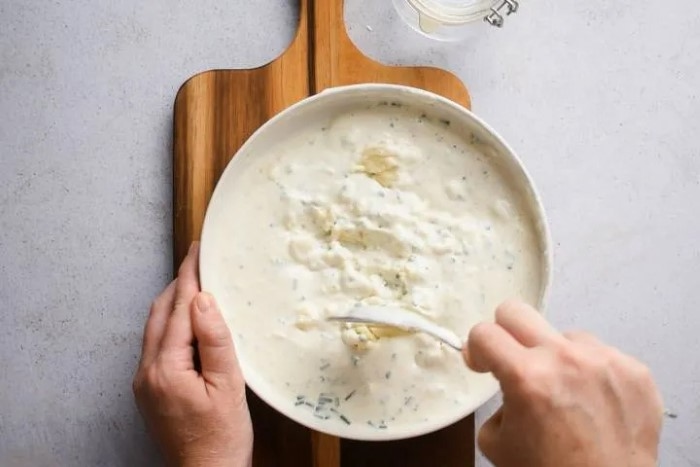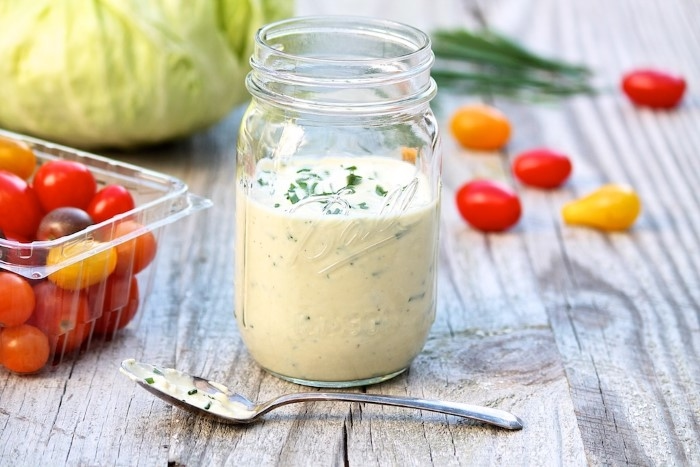There is absolutely nothing that is equal to Gorgonzola dressing in terms of rich, tangy and absolutely creamy salad dressing. Italian-inspired dressing is bold, flavorful and luxurious – prepared with the ideal combination of the Gorgonzola cheese, cream and the basic seasonings. It will add a twist to whatever you eat, be it in a salad or a buffalo wing dip, or with a steak, you will have this dressing lifting your food instantly.
In this post, we will explain what Gorgonzola dressing is and how to make it yourself with fresh ingredients, the difference between Gorgonzola and blue cheese, and which dishes it pairs best with.When you’re in the mood for a creamy dressing — ranch, say, or Caesar, but deeper and more nuanced — your next great obsession may well be Gorgonzola dressing.
Table of Contents
What Is Gorgonzola Dressing?

Gorgonzola dressing: It is the sauce consisting largely of gorgonzola cheese, which is a variety of blue cheese that originates in Italy and has a sharpness and/or tang with a crumbly texture. And then, it’s thrown in with something like mayonnaise and sour cream or buttermilk, garlic and a twinge of vinegar or lemon juice until you have a creamy salad dressing that the cheese flavor is emboldened without being overwhelming.
Contrary to most dressings which depend on the presence of herbs or sweetness, Gorgonzola dressing is a pride of boldness. The cheese makes it salty with a specific bite but the cream based components tonify the sharpness. The result? An indulgent, sophisticated dressing that will be ideal in salads, meat or a dip to vegetables.
The Secret Gorgonzola Cheese
Gorgonzola cheese is from the Northern regions of Italy. It is made with cow milk and developed several types of mold which grow into veins throughout during its aging process, creating its unique blue-green appearance. It comes in two principal types: Gorgonzola Dolce (sweet) and Gorgonzola Piccante (strong).
- Gorgonzola Dolce is smoother, more creamy, and sweeter – good with smooth salad dressings.
- Gorgonzola Piccante is more powerful and aged with more tangy taste – it is ideal when one wants to enjoy a strong and pronounced taste.
Most of the chefs who make dressing suggest Gorgonzola Dolce because it is easy to mix, and it provides a smoother texture. But when you are in the mood of a stronger bite, then the Piccante version brings out the complexity and depth.
Gorgonzola Dressing Homemade
Gorgonzola dressing is so unbelievably simple, and only takes 10 minutes to prepare. The simplest and most traditional way to try it is:
Whip-up the Gorgonzola cheese in a mixing bowl. Stir in mayonnaise, sour cream and buttermilk. Beat till the mixture is smooth. Then mix in a clove or 2 of minced garlic, squeeze of lemon juice or white wine vinegar and salt and freshly ground black pepper; taste, and keep adjusting. If you want a thinner dressing, stir in additional buttermilk or milk until it’s the consistency that you like.
To add a bit of extra flavor, some cooks will stir in chopped chives or parsley, or a drizzle of olive oil. Chill dressing for at least 30 minutes before serving- allows the flavors time to marry.
When done right, homemade Gorgonzola dressing is fresher, creamier and just plain old realer than the stuff you buy in a bottle.
Gorgonzola Dressing and Blue Cheese Dressing
Blue cheese dressing is mistaken for Gorgonzola, and it’s not the same thing. While they do use blue-veined cheeses, the savory profile of Gorgonzola is undeniably Italian. In the U.S., blue cheese dressing is typically made with a saltier and sharper-tasting blue cheese like Roquefort, Danish Blue or Stilton.
On the other hand, Gorgonzola dressing is creamier and a little milder with a buttery ending. It is more agreeable, and not so heavy handed – it is suited to light greens, or light meats. Therefore, the two are similar in terms of texture, but the difference of the flavor is very noticeable.
How to have Gorgonzola Dressing at the best

This dressing is not confined to salads only. It is incredibly flexible and may be applied in numerous creative applications:
- Over Steak or Burgers: The rich tangy sauce is quite fitting with fat meats.
- When you have Chicken Wings: A yummy alternative to ranch- this is a good flavor to apply to hot wings.
- On Wedge Salad: Can never go wrong with the classic iceberg lettuce, bacon and tomato Gorgonzola dressing.
- As a Dip to Vegetables: This is great with carrot sticks, celery and broccoli.
- On Sandwiches or Wraps: Use as a spread to turkey, roast beef and grilled vegetables.
This is a dressing you should absolutely have on hand for everyday meals, but especially holidays, because the combination of cream and tang marries perfectly with fatty or spicy foods.
Variations You Can Try
While you won’t be able to refuse the old standard, Gorgonzola dressing is very easy to adjust to your personal preference.
- Credit: Light Version: Greek yogurt is a healthier and more protein-dense alternative to sour cream or mayonnaise.
- Herb-Infused: It will be garnished with a chiffonade of fresh herbs like thyme, dill or parsley to add some freshness.
- More Zesty: Sprinkle in a little Dijon mustard or apple cider vinegar for an added tang.
- Thick and Chunky: Add additional crumble cheese and reduce liquid amounts in case you want to be thick.
You have to experiment with ratios until you come up with your ideal blend – that is the beauty of homemade dressings.
Storage and Shelf Life
The homemade Gorgonzola dressing must be kept in a refrigerator in an airtight jar or bottle. It typically remains fresh within a maximum of one week. Stir it well before use since it may thicken with time.
Do not freeze it, the dairy constituents may separate upon being thawed. When it gets too thick when refrigerated pour a splash of milk or buttermilk into it to loosen it.
Health Advantage and Food Knowledge
Although there is no denying that Gorgonzola dressing is rich, it contains some nutrients in a reasonable quantity as well. The cheese is also rich in calcium and protein which is beneficial to the bones and muscle repair. There is also a good fats in the dressing which is said to make one feel full.
That notwithstanding, since it contains creamy ingredients, it is important to have moderation. In case you are tracking the calories/fat consumed, you can make the light one using yogurt or low-fat sour cream. In doing so, you will remain having the delicious taste with fewer calories.
Frequently Asked Questions (FAQs)
What does Gorgonzola dressing taste like?
It’s creamy, tangy and a touch salty with the luxurious feel of butter. The flavor is aggressive but also balanced, especially if you use Gorgonzola Dolce.
Is there a blue cheese that I can substitute for Gorgonzola?
Yes, you can. Blue cheese would be fine, though the dressing will have a bolder, saltier bite than with the creamy Gorgonzola.
How long does homemade Gorgonzola dressing last?
Stores up to one week in a well-sealed container in the refrigerator.
Can I make it vegan?
For alternatives, you can do plant-based sour cream and vegan blue cheese but the flavor won’t be spot-on.
How is it best used in salads?
It’s so great with wedge salads and spinach, arugula or roasted vegetable salads too. 2.Drizzle lightly and toss gently for even coverage.
For the flavor-forward, Gorgonzola dressing is the superb creamy condiment. More than a salad topper, its smooth consistency and tangy richness elevates it into gourmet fare. Whether it’s thick and chunky or light and tangy, this dressing is a game changer that will transform any dish into something memorable.
So the next time you have a hankering for creamy dressing, say no to that store-bought bottle and mix up your own Gorgonzola at home. Because after you taste that perfect marriage of cheese, cream, and zing- you will never want a regular ol’ dressing ever again.

